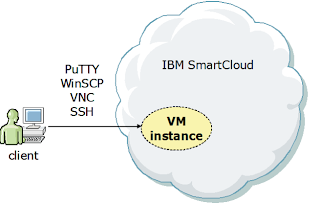[This article was submitted for future publication on ThoughtsOnCloud.com]
Remember the skepticism around online
shopping and e-commerce sites back in the day when the web was young?
Everyone was afraid of giving out their credit card information over
the Internet, for fear it would be intercepted. We eventually got
over that fear, thanks to encryption technologies such as Secure
Sockets Layer (SSL), which make e-commerce much safer today. That
same technology also plays a role in cloud security, and that is one
thing to consider, along with other security issues when moving your
application to the cloud.
Public
cloud versus on-premises
You basically have the same security
issues and considerations for deploying applications on the cloud as
you do for running them on premises. The difference is that on cloud,
some of those issues are handled by your cloud service provider. The
important thing to consider is how far the cloud service provider's
responsibilities extend, and where your responsibilities as the
client, or virtual machine (VM) instance owner, take over.
First, thoroughly investigate your
cloud service provider's policies. Treat them like any other
outsourced service. Check their references. Clearly define the
service level agreements (SLAs) in your contract. SLAs can cover
things like backups, up time, disaster recovery, change management,
and so on. Audit your cloud provider or consider third-party audits
to ensure that those policies are enforced.
For example, the IBM
SmartCloud Enterprise has many mechanisms in place to offer a
safe and secure environment, such as:
- Firewall and intrusion protection system (IPS) between guest VMs and the Internet
- IP-filtering technology and multiple IP addresses per instance for enabling security zones
- Optional virtual private network (VPN) and virtual local area network (VLAN) isolation of account instances
- Encrypted connections: IBM is isolated from customer VMs through customer secure shell (SSH) keys and server passwords
- Hypervisor-based (kernel-based virtual machine) isolation with client-configurable firewall rules
- Public images patched and scanned regularly
- Patch servers for private images
- Root access for customers to guest virtual machines, allowing further hardening of VMs
- No sharing of private images between accounts on the cloud
- Access to the portal and APIs, which requires a user ID and password
Users must comply with IBM's stringent
security policies, and are subject to regular security scans.
Not all cloud providers offer the same
kind of protection, so do your homework!
Image
— or instance — is everything
As a VM instance owner on the IBM
SmartCloud, you have root access and control over that instance as if
it were one of your own on premises, and you are responsible for
security on the instance itself. That means that it is up to you to
configure access to that resource, install and run anti-virus
software on it, and so on. Treat it like any other client in your
enterprise; it is just as vulnerable to threats and attack. This blog
post lists several useful links to articles about securing and
managing your instances.
Get
started with the IBM SmartCloud Enterprise: This article
describes how to securely connect to, configure the firewall of, and
manage (encryption) keys for your instances. You should take care of
these tasks immediately upon creating your instances. Determine who
will need access to your instances, determine the firewall ports that
need to be open or closed, and be prepared to use and manage keys for
access.
Why key management
is important
IBM SmartCloud employs encryption so
you can control access to your applications and data in the cloud.
However, encryption alone does not guarantee security. Keys must also
be stored and managed properly.
Secure
multi-user access to IBM Cloud instances with VNC and SSH:
Provides a detailed description of how to configure cloud instances
and clients for secure access.
IBM
SmartCloud Enterprise tip: Integrate your authentication policy using
a proxy: Describes how to create a proxy bridge between your
homegrown applications and the IBM SmartCloud. This bridge can allow
you to implement finer-grained access control that cannot be directly
implemented in the IBM SmartCloud portal. In other words, you can use
this technique to control not only who can access, but how, where, or
when they can access data.
IBM
SmartCloud Enterprise tip: Secure access for Android devices:
Describes how to set up secure access to a cloud instance for Android
mobile devices.
Cloud
security considerations: This good general article is about
high-level cloud security concepts. This is just the tip of the
iceberg, but it does give a very concise overview.
Extra credit
Model-driven
cloud security:
This article discusses the challenges of cloud application security
policy automation and describes how it can be achieved through a
model-driven security architecture and deployment.

Nice Post! One of the main reasons that people think a public cloud will be more secure than a private cloud is that the company offering the service is going to want to keep the public cloud safe, since there are so many people who use it.
ReplyDeleteDrupal Hosting I Cloud For Developers